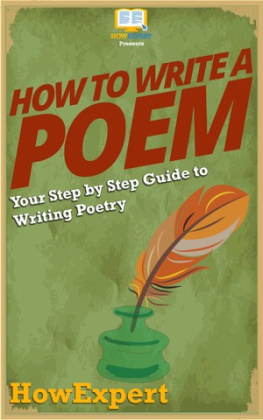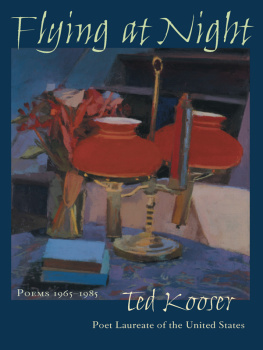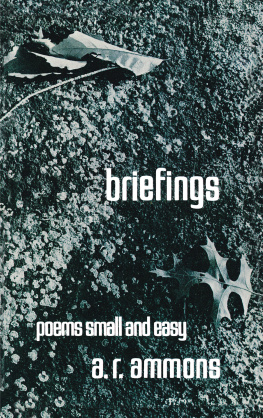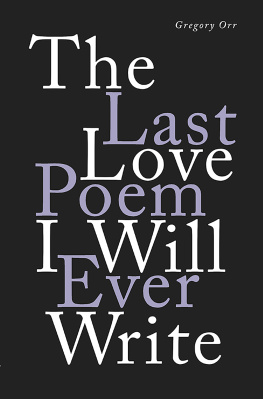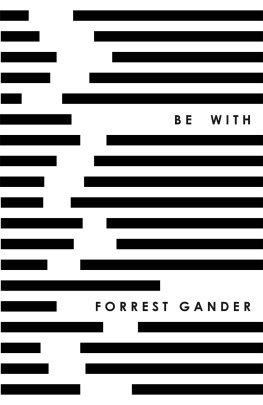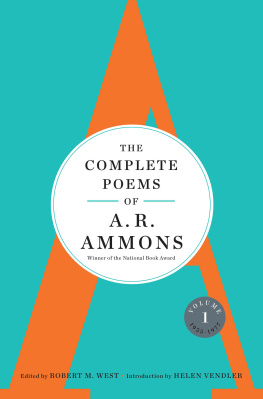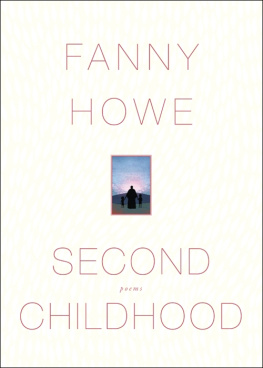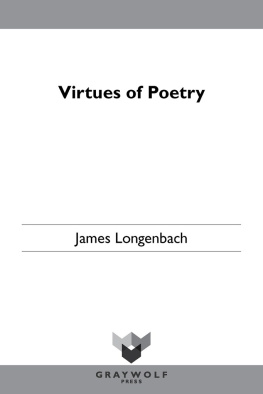
HOW POEMS
GET MADE
ALSO BY JAMES LONGENBACH
PROSE
The Virtues of Poetry
The Art of the Poetic Line
The Resistance to Poetry
Modern Poetry after Modernism
Wallace Stevens
Stone Cottage
POEMS
Earthling
The Iron Key
Draft of a Letter
Fleet River
Threshold
JAMES LONGENBACH
_____________
HOW POEMS
GET MADE
______________________________
_____________

Copyright 2018 by James Longenbach
All rights reserved
First Edition
For information about permission to reproduce selections from this book, write to Permissions, W. W. Norton & Company, Inc., 500 Fifth Avenue, New York, NY 10110
For information about special discounts for bulk purchases, please contact W. W. Norton Special Sales at specialsales@wwnorton.com or 800-233-4830
Book design by Brooke Koven
Production manager: Julia Druskin
COVER DESIGN BY YANG KIM
COVER ART SONG_MI / SHUTTERSTOCK AUTHOR PHOTOGRAPH BY J. ADAM FENSTER, UNIVERSITY OF ROCHESTER
ISBN: 978-0-393-35520-8 (pbk.)
ISBN: 978-0-393-35520-8 (eBook)
W. W. Norton & Company, Inc., 500 Fifth Avenue, New York, N.Y. 10110
www.wwnorton.com
W. W. Norton & Company Ltd., 15 Carlisle Street, London W1D 3BS
To Russ McDonald
CONTENTS
T he impulse to be lyrical is driven by the need to feel unconstrained by ourselves. As poems have testified for centuries, we become lyrical when we suffer, when we love. But like poems themselves, we exist because of constraintscultural and linguistic ways of organizing experience that allow us to know who we are. Why, when were driven to be lyrical, are we gratified by the repetition of words, rhythms, and phrases? Why, having experienced the pleasure of a lyric poem once, do we want to experience it again? Why, when were in love, can the repetition of an experience feel more fulfilling than the discovery?
This book describes how English-language poems get made from the most fundamental elements of their medium: the diction, syntax, figures, and rhythms of the English language itself. Because of a poets organization of these elements, some poems may also be distinguished by qualities we call (more metaphorically) voice, image, or tone. These same qualities may distinguish prose, but through the simultaneous repetition and disruption of patterns, lyric poems aspire (sometimes literally, more often metaphorically) to the condition of song. Nobody rereads Keatss ode To Autumn to be reminded that in September leaves turn colors and fall from the trees; even if we know the poem by heart, we savor our experience of the poems language as it unfolds in time, luring us forward.
There is of course a great deal to be said about diction, syntax, figuration, rhythm, or tone, and my goal is to offer succinct accounts of the poetic procedures with which any writer or reader would want to be intimate. Aspects of poems not registered in my chapter titles (such as line, rhyme, punctuation, disjunction) are treated along the way, each chapter building on the one preceding it, the whole book moving toward an ever-widening account of how poems are structured not as static vessels for meaning but as temporal events. While our first encounter with anything from a poem to a parking ticket might be revelatory, reading the same paragraph from a ticket as many times as one has read the ode To Autumn would probably not be satisfyingexcept if the paragraphs language enacts an emergence, a coming into being, that feels infinitely repeatable, richer over time.
Among the poets whose procedures Ill describe are Blake, Crane, Dickinson, Donne, Keats, Lawrence, Moore, Shakespeare, and Wyatt, along with a small array of contemporaries. Because they hold our attention as repeatable events, the best-known poems may seem wonderfully strange, especially after long acquaintance. And because their medium, the language we speak every day, is itself so familiar, we may experience the pleasure of what Ill call lyric knowledgethe eager rediscovery of what we already knownot only when we least expect it but when we expect it too well. A poem gets made not only in the act of composition but every time we read it again.
T he medium of Giorgiones Tempest is oil on canvas; the medium of Robert Rauschenbergs Bed is oil and pencil on pillow, quilt, and sheet. Very few people handle oil paint as provocatively as Rauschenberg, but lots of people sleep on sheets. Those people may also draw a little, they may have a fine sense of color, but they respect the transaction between artist and medium that a particular work of art not only records but embodies. Sometimes, however, when the sheer otherness of the medium is foregrounded at the expense of a conventional signal of the artists mind at work, people dont respect the transaction, in part because the artist doesnt covet such respect: how can art be something made of a bed sheet?
How can art be something made of words? Unlike the media most commonly associated with visual or musical artistry, words are harnessed by most people during almost every waking moment of their lives; theyre more like sheets than like oil paint or the notes of the scale. Even small children are skilled manipulators of language, capable of detecting and repeating the most subtle nuances of tone. But children dont write the poems of Shakespeare or the novels of Henry James, and neither do most adults. We may sustain an easy mastery of language in our daily lives, but once we engage language as an artistic medium, that mastery is never secure: our relationship to language is constantly changing as we discover aspects of the medium that not only our prior failures but, more potently, our prior successes had occluded.
My medium is not language at large but the English language. When I was young I took this for granted, but over the years Ive become increasingly conscious of the qualities shared by sentences because theyre written in English, rather than German or French. The very word medium , derived from Latin, did not enter the English language until the Renaissance, when it referred to something that acts as an intermediary, like a piece of money or a messenger, and it was not until the nineteenth century that the word began to be used to describe the stuff from which art is made: the artistic medium enables a transaction between the artist and the world, and, over time, the history of those transactions has become inextricable from the medium itself. Its not coincidental that it was also in the nineteenth century that the word medium was first used to describe a person who conducts a sance, a person who exists simultaneously in the worlds of the living and the dead.
Every language has different registers of diction, but English comes by those registers in a particular way, one that reflects the entire history of the language. Old English, the language of the eighth- or ninth-century poem we call The Seafarer, now looks and sounds to us like a foreign language, close to the German from which it was derived: with some study, one can see that the Old English line bitre brostceare gebiden hbbe means bitter breast-cares abided have or I have abided bitter breast-cares. The language of Chaucers fourteenth-century Canterbury Tales , or what we call Middle English, feels less strange, in part because its syntax now relies largely on word order rather than on word endings: Thanne longen folk to goon on pilgrimages or then people long to go on pilgrimages. And the Modern English of the Renaissance we can read easily, because it is the language we speak today, even though the language has continued to evolve.
Next page


